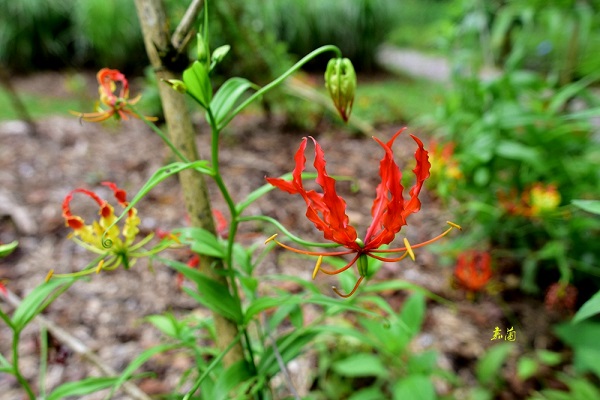Flame lily is a tuberous herb, which is widespread in tropical and southern Africa and in tropical Asia. The generic name Gloriosa means ‘full of glory’ and the specific epithet superba means ‘superb’, alluding to the striking red and yellow flowers.
All parts of the plant, but especially the tubers (swollen, underground stems), are extremely poisonous and the ingestion of flame lily has caused many accidental deaths. It has also been used to commit murder, suicide, to induce abortions and to poison dogs. African porcupines and some moles are reputed to be able to consume the roots with no ill effects.
Geography and distribution
Native to tropical and southern Africa, and temperate and tropical Asia (where it occurs in China, Indochina and from the Indian Subcontinent to the Lesser Sunda Islands). It has been found up to 2,500 m above sea level. It is widely naturalised (including in Europe and Australia) and is listed as a weed in Australia and in some parts of the USA. Gloriosa superba is common throughout much of its range. However, in some areas of India (Patalkot, Chhindwara District), Bangladesh and Sri Lanka it has been assessed as rare, and natural populations are believed to be in decline. In the Indian state of Orissa, for example, where G. superba used to be common, it is now on the verge of extinction according to the Wildlife Institute of India.
Description
A perennial, tuberous, climbing (sometimes erect) herb, up to 4 m long. The leaves are simple (undivided). The leaf blade has strong, parallel nerves and ends in a tendril-like spiral. The solitary flowers are bisexual, showy, pendulous and 4.5–7 cm in diameter. The pedicel (flower stalk) can be up to 20 cm long. The flowers are usually red and yellow with crisply waved margins. The fruit is a large (up to 6 cm long), oblong capsule. It is thought that pollination is probably carried out by butterflies and sunbirds.
Threats and conservation
Flame lily is in decline in some areas of India, Sri Lanka, Bangladesh and southern Africa, due to over-collection of the seeds and tubers. Although commercially cultivated in southern India, it is estimated that pharmacies and drug manufacturers in India fulfil up to 75% of their raw material demand from wild populations.

